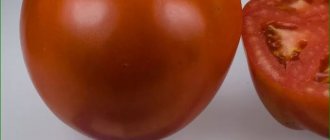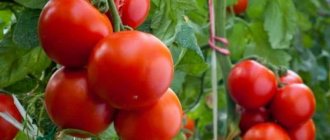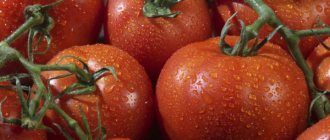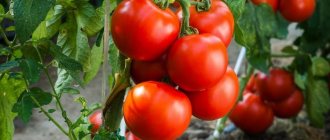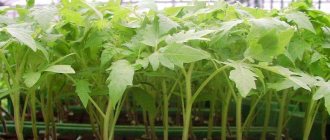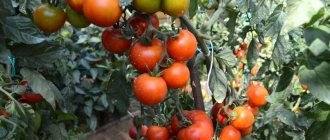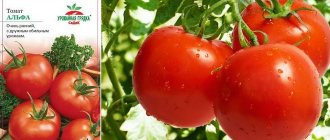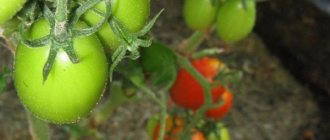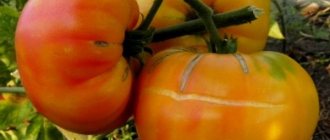Vegetable growing » Tomatoes
0
1312
Article rating
Kira Stoletova
Tomato Beefsteak is a variety of non-usual form of Moscow selection. It was bred relatively recently and entered into the official register in 2009. But even in this short period, he was able to win the hearts of many gardeners and is now grown throughout the country.
Characteristics of Beefsteak tomato variety
The main feature of the variety is not only the interesting shape of the fruit, but also its high yield. From one bush you can get up to 3.5-4 kg. tomatoes per season. In order to achieve abundant fruiting, you need to know about the characteristics of the variety and be able to provide it with good conditions for growth.
Description of the Beefsteak tomato variety with photo
Judging by the description of the originators, breeders from Moscow, Beefsteak tomatoes are a mid-season variety that produces a consistently rich harvest. It begins to bear fruit 105-110 days after sowing the seeds. This is not a hybrid, which makes the Beefsteak tomato even more popular, since you can collect the seeds yourself.
Important! Varietal qualities are fully preserved.
Description of the bush
The plant belongs to the indeterminate varieties due to the absence of a growth point limitation. That is why the bushes grow powerful, up to 1 m in width. This fact must be taken into account when planting so that Beefsteak tomatoes have enough feeding area. Only in this case can you get a sufficient number of large fruits.
Thick stems grow up to 2 m and require tying, otherwise they may break. The bush is lush due to the large number of stepsons. They must be removed in a timely manner so as not to weaken the plants.
Attention! The bushes are grown with two, rarely three stems.
The juicy green leaves are ordinary, tomato-type, with a pronounced odor. They are quite large. Since there are many leaf blades, they will have to be removed throughout the growing season. Otherwise, problems with fungal diseases cannot be avoided due to lack of ventilation.
The brush of the Beefsteak tomato is simple; as a rule, there are about 5-6 inflorescences on it. The first of them is formed in the axil of the eighth leaf, and then through 2-3 joints. Almost all flowers are set, but if you need to get large fruits, then it is best to leave no more than 2-3 green tomatoes.
Description of fruits
The Beefsteak tomato, if you follow the norms of agricultural technology, has an impressive size. The weight of the fruit varies between 260-290 g. There are also record holders that grow over 350 g.
Tomatoes have a round shape, slightly flattened horizontally. Ribbing is observed in the area of the stalk, but it is insignificant. When ripe, tomatoes turn deep red.
Comment! Under the same name there are tomatoes with a yellowish color; they are also called white.
Yellow tomatoes are considered dietary, since fruits with this color do not cause allergies.
The fruits of the Beefsteak variety have a sweetish pulp. It is the same shade as the skin. On the cut you can see 6-8 seed chambers. The fleshy fruits have thin skin, so it is difficult to transport them when ripe. You can pick blanc tomatoes, as they ripen well.
When cutting, Beefsteak tomatoes do not leak juice, since they contain little liquid.
Attention! On an industrial scale, due to the thin peel and short shelf life (no more than 4-5 days in the refrigerator), the Beefsteak tomato variety is practically not grown.
Use in cooking
Due to their size, the fruits of the Beefsteak variety are mainly used for preparing products from it . They look very beautiful cut into slices, and serving them with white tomatoes will become an original decoration for any holiday table. As for preservation, it can be done by cutting them into slices, since such large tomatoes simply will not fit into a jar.
And in conclusion, we can say that, in addition to many main advantages, this tomato variety has a large amount of nutrients, as well as vitamins, especially groups A and C.
Characteristics of Beefsteak tomato
When choosing a variety, you need to know its characteristic characteristics. This applies not only to the characteristics of cultivation, but to other parameters:
- yield and fruiting time;
- pros and cons of tomatoes;
- ways to use it in cooking.
Beefsteak tomato yield and fruiting
Mid-season Beefsteak tomato can be grown in open ground, but only in the south. As for the Northern regions, it is best to use a greenhouse or film shelters for planting.
Tomatoes grown from seedlings ripen in mid-summer. Harvesting continues until the first frost. In protected soil, one plant produces up to 4 kg of tasty fruit. On ordinary ridges there is a little less. The main culprits for yield reduction in open ground are rain and fog, when not all anthers crack. This leads to the appearance of barren flowers. The number of fruits is also affected by non-compliance with agricultural technology.
Comment! If frosts are expected at the beginning of September, the fruits can be picked at ripeness and ripened in a dark place.
Area of application of fruits
Fleshy Beefsteak tomatoes are highly valued by chefs. Fruit drinks and juices, tomato paste and ketchup, various salads, and adjika are prepared from them, in which slices are used or the fruits are ground in a meat grinder.
But the most important purpose is fresh salads.
Due to its massiveness, the Beefsteak tomato is not used for whole-fruit canning.
Resistance to diseases and pests
The Beefsteak tomato is highly resistant to many pests and diseases of nightshade crops. In particular to such as:
- tobacco mosaic;
- cladosporiosis;
- Alternaria blight.
But it is not always possible to protect tomato bushes from late blight and gray rot.
Pros and cons of the variety
Like many varieties of crops, the Beefsteak tomato has its advantages and disadvantages.
One cluster may contain ripe and greenish fruits
pros
- excellent taste of fleshy tomatoes;
- beautiful appearance;
- large fruit;
- almost 100% flower setting;
- stable and high yield;
- variability of culinary uses of fruits;
- high resistance to diseases and pests.
Minuses
- defeat of bushes by late blight;
- short shelf life and impossible transportation of ripe fruits.
Features of cultivation
To obtain an excellent harvest, you will first need to grow high-quality seedlings. There are a number of rules that must be followed in order not to be disappointed in the Beefsteak tomato variety.
Planting seedlings
To plant, it is not necessary to buy seeds every year; you can collect them yourself.
Before planting, the seeds are treated with a solution of Zircon, Epin or potassium permanganate. This will protect the seedlings from fungal diseases. Then it’s worth drying them to a free-flowing state.
Preparation of soil and containers
To sow Beefsteak tomato seeds for seedlings, you will need nutritious soil. You can use a ready-made mixture or make your own soil. To do this, take the following components:
- peat;
- leaf soil;
- humus;
- river sand;
- wood ash.
Warning! It is prohibited to add fresh manure to the soil.
Before sowing, the soil is scalded with boiling water and potassium permanganate.
The containers are also prepared. To do this, wash them with hot water and soap, then rinse. Pour over boiling water with potassium permanganate. You can use boric acid or hydrogen peroxide for treatment.
Terms and rules of sowing
Sowing of seeds begins in late February or early March. The timing depends on the climatic conditions of the region. It should be borne in mind that high-quality seedlings should be 56-60 days old with a strong, thick stem.
Seeds are sown in furrows located at a distance of 3 cm. Planting depth is no more than 1.5 cm. After sowing, irrigate the soil with a spray bottle and cover with film so that the seeds germinate faster.
Any container can be used for sowing
Seedling care
Young plants are demanding of heat and light. If there is not enough sun, you will need to install phytolamps. Watering is carried out as needed. Too soggy soil can lead to problems with the root system. You can use iodine as a supplement (one drop of the substance from the pharmacy is enough for a 3-liter jar).
Picking
As soon as 3-4 true leaves appear, the Beefsteak tomato seedlings need to be plucked, that is, transplanted one at a time. The soil composition should be the same as when sowing seeds.
Tomato seedlings are not afraid of transplantation, this makes the root system more powerful
Transfer
The Beefsteak tomato is planted in a permanent place when the plants are at least 60 days old, in loose soil. For 1 sq. m place two, maximum three seedlings.
And add humus and wood ash to the holes and pour boiling water over them well. After planting, the seedlings are moistened. The next irrigation is planned in 2-3 days.
Aftercare
Further care for Beefsteak tomatoes comes down to traditional measures:
- watering and fertilizing;
- loosening the soil, removing weeds;
- removing leaves, forming a bush.
It is advisable to mulch the soil in the tree trunk circle to retain moisture
Watering, fertilizing
You need to water little and often, since, unlike other varieties, the Beefsteak tomato does not tolerate large amounts of moisture. For feeding, you can use mineral fertilizers with potassium and phosphorus, as well as a solution of fermented grass and wood ash.
Advice! You need to feed the Beefsteak tomato after preliminary watering, then mulch the circle around the trunk.
Stepsonning, garter
Tall bushes of the variety must be tied up throughout the growing period. Brushes are also subjected to the same procedure to prevent them from breaking.
Excess foliage and shoots are also removed to get a rich harvest of Beefsteak tomatoes and ensure good air circulation.
Agricultural technology
The future large harvest is laid at the stage of growing seedlings. It is then that the ability to set a sufficient number of flower clusters is formed, and Beefsteak, with proper care, can have up to 7 of them.
Therefore, everything must be done to ensure that the seedlings do not stretch out and grow stocky and strong.
Growing seedlings
How to grow high-quality seedlings? There are several components of success here:
- properly selected and treated soil. It should not only be loose and breathable, but the optimal nutrient content is the main condition for successful growth and proper development of plants. To ensure the health of the seedlings, the soil is steamed or frozen, destroying all pathogens;
- seeds processed according to all rules. They need to be calibrated - only a large seed can produce a healthy plant, pickled to destroy all possible pathogens, awakened with the help of growth stimulants, germinated to select only viable seeds;
- correct sowing: the depth of immersion of a tomato seed in moist soil is about 2 cm;
- greenhouse conditions before germination. To prevent moisture loss, the container with the seeds is placed in a plastic bag; a constant temperature of about 25 degrees ensures that it is kept in a warm place;
- Spartan conditions after germination. A temperature of about 16 degrees during the day and a couple of degrees at night is what is needed for the roots to grow and the stem not to stretch; the maximum amount of light will also contribute to this;
- comfortable conditions for future growth: temperature about 22 degrees during the day and a little colder at night, enough light, regular moderate watering with non-cold water, liquid fertilizing with low concentration mineral fertilizer solutions 2 to 3 times during the growing season. Often, when growing seedlings, they maintain the desired air temperature, but they forget that the roots of tomatoes need warmth. A cold window sill is a common cause of poor seedling development. It needs to be insulated from drafts with polystyrene foam or penofol;
- sufficient distance between plants, pots cannot be placed close to each other, the struggle for light will lead to the inevitable stretching of seedlings.
Propagation of Hydrangea paniculata by cuttings in autumn is the best way +Video
Criteria for readiness of seedlings for planting:
- age from 50 to 60 days;
- at least 7 true leaves;
- presence of the first flower brush.
If by this time the soil in the greenhouse is warm, it is time to move the seedlings to a permanent place of residence.
Features of cultivation
Tomatoes from the beef group have certain requirements for living conditions. If you do not follow them, you cannot count on a good harvest of large fruits.
The planting rate for Beefsteak tomato is 3 plants per square meter. m. Even before planting, you need to provide everything for gartering the plant - pegs or trellises.
For this variety of tomato, soil fertility is very important. To produce a large harvest of large fruits, the plant removes a lot of nutrients from the soil. In the first phase of development, green mass increases, so the need for nitrogen is high. If it is deficient, plants develop slowly and you cannot get a large harvest from them. But if there is an excess of nitrogen, it may not be obtained at all. Not only does the rapid growth of shoots inhibit the formation of flower buds and the formation of a crop, plants overfed with nitrogen have weak immunity and become defenseless against pathogens of fungal diseases. Late blight begins to rage, from which it is very difficult to save plants.
Mulching plants with fresh sawdust will also help reduce the nitrogen content in the soil during overfeeding. They pull excess nitrogen from the ground to decompose. After 1.5 or 2 weeks, sawdust must be removed from the greenhouse.
At the stage of budding and fruit set, potassium should predominate in the fertilizing. At the same time, it is necessary to feed the plants with calcium nitrate - prevention of blossom end rot. After 2 weeks, fertilizing is repeated.
The soil should always be under a 10 cm layer of mulch made of organic materials. It provides many advantages for plant development: stable soil temperature and moisture, maintaining its loose structure, and preventing weed growth.
Proper watering is very important. If there is not enough moisture, plants experience stress and their development is delayed. With excess moisture, the content of dry substances and sugars in fruits decreases, which negatively affects the taste of the fruit. High humidity in the greenhouse promotes the development of late blight.
If you follow these simple rules, you can hope for a maximum harvest of tasty and large fruits.
More information about the characteristics of the Beefsteak tomato variety can be seen in the video:
